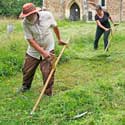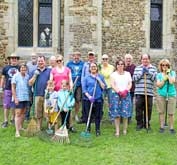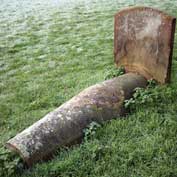Photos and text by Peter Mann
While the church of St Denis, East Hatley is no longer in use, the churchyard remains consecrated ground, open for burials.

Scything in St Denis’ churchyard, July 2023, led by Richard Brown from Wild Scythe.
Photo / Peter Mann.
It has also been designated a Local Nature Reserve (LNR) and a County Wildlife Site, managed by a small group of local volunteers who organise – weather permitting – regular churchyard tidy-ups, adhering as far as possible to the site’s management plan (see below).
Currently, the local volunteers of the St Denis’ LNR management group are Nicola Jenkins, Sebastian Kindersley, Peter Mann and the Rev’d Hilary Young (representing Gamlingay Parochial Church Council).
When it comes to tidying up the churchyard, we are very fortunate more than a few people from East Hatley turn out to help – typical members of our merry band are photographed below: click the picture for their names.
New volunteers are always very welcome – just bring your gardening gloves and a grass rake and have a good workout for an hour or so.
In 2013, thanks to a grant from South Cambs District Council’s Community Chest, we obtained a scythe / scissor mower to help to make the late summer ‘big’ cut of the very long grass around the church and the gravestones a relatively efficient activity. We even had the mower blessed!
More recently, a mini-team of scythers (pictured above – click on it for a larger version) cut part of the south side: Richard Brown from Wild Scythe led six volunteers from Gamlingay and Hatley in a scything training session. Richard is pictured with Kate Laugharne, Revd Hilary Young, Nicola Jenkins and (just visible) Peter Condon.
Grass grows
But, why the bother and why allow the grass to get so long?
Well, as the churchyard is a Local Nature Reserve, you can expect to find plenty of wild flowers in the spring and early summer.
There are also lots of insects and butterflies hopping and fluttering around and quite a few small mammals all enjoying (one assumes) the undisturbed meadow that is the churchyard.
In allowing the wild flowers to seed, the grass will, unfortunately, grow… and grow – if not cut back it forms patches of thick tussles, which are a pain to deal with, and choke out the cowslips that are such a feature of the Hatley countryside; oxlips have already suffered this fate, although they may have been victim of marauding deer and muntjacs which have a particular liking for them.
Likewise, hawthorns and other bushes / trees will also either self-seed or have seeds ‘planted’ by passing squirrels and jays and if left would, within five or six years, present a formidable problem.
Mole hills and ant hills are more obstacles to a neat and tidy graveyard, the latter, which produce a sticky clay, being particularly difficult to deal with.
On top of this, of course, it is a ‘living’, consecrated graveyard, where any of us can be buried; several of the graves are still attended by relatives of those interred there. The most recent burials were in November 2018 of John Lanchberry, a much-missed willing helper during our tidy-up sessions, Patricia Brown in June 2019 and, in June 2023, the ashes of Ishbel Beatty.
Management plan
With the help of Rob Mungovan, when he was the Ecology Officer at South Cambridgeshire District Council, the churchyard management committee, formed some 25 years ago, agreed a management plan in 2010 for the ideal grass cutting times throughout the year: the south side of the churchyard to be cut in March, again in April or May and the whole churchyard to be cut in July and September.
Strimming around the church and the graves and cutting back excessive growth in the hedges around the edge of the churchyard is part of each session.
Kind weather always helps of course – 2012 was particularly difficult weather-wise (which is when the idea of a scythe / scissor type mower was first considered) whereas in several other years it has been dry enough to be cut and collected by myself using my ride-on mower.
Special things about St Denis’ churchyard
There are only 20 or so marked graves in the churchyard – they are listed in Grave inscriptions 1987, its cover having a sketch, dated 1748, of St Denis’ by Rev William Cole.
A ‘feature’ of graveyards in the Bedfordshire area are ‘corpse’ style graves – there’s one in St Denis’ graveyard, although whether the solid lump of stone (probably granite) belongs to the headstone of Elizabeth Thorpe, who died on 31st July 1838, aged 37, is a moot point.
She was, as her headstone declares, the wife of Charles Thorpe the rector of St Denis, which probably explains its position next to the main entrance to the church.
Possibly the best known grave is of John Perkins a friend of W G Grace, the cricketer, a keen huntsman and much more – you can read about him in ‘The man who lived at the Palace‘.
As you’d expect of a Local Nature Reserve and a County Wildlife Site, the churchyard is quite rich in flora, fauna and insects – not forgetting the cave spiders in the undercroft. This page on the flowers, insects and graves, will tell you more (as will our ‘nature‘ page).
Other links of interest are:
- Churchyard regulations for graves – Diocese of Ely’s guide for families and next-of-kin.
- Map of St Denis’ churchyard – a Cambridgeshire County Council county wildlife site.
- Nature – things to be found and seen in the St Denis’ Local Nature Reserve
- Leaflet – St Denis’ churchyard county wildlife site (Wildlife Trust).
- Species list 1978 to 2014 – a spreadsheet listing all the plants, bushes and trees in the churchyard (Wildlife Trust / Excel file).
- Species list 2012 – a second spreadsheet listing all the churchyard’s plants, bushes and trees (Wildlife Trust / Excel file).
- Species list 2007 to 2020 – a third spreadsheet listing all the churchyard’s plants, bushes and trees compiled by Dr Jonathan Shanklin, the county’s botanical recorder, on 4 July 2020. He recorded 143 species (Wildlife Trust / Excel file).
- Species list 1992 to 2021 – a fourth spreadsheet listing all the churchyard’s plants, bushes and trees carried out by Dr Jonathan Shanklin, the county’s botanical recorder following his visit with the Cambs Flora Group on 30 March 2021. He recorded 10 species for the first time, with 18 records being made this year. NB The year of the first sighting and last sighting of a species is noted, as is the frequency of record – these are biased by the fact that the site has not been visited each year and often at different times of year, so an absence of record one year is not necessarily an absence of species (Wildlife Trust / Excel file).
- Site recording card 2012 (Wildlife Trust / Word file).
- Site recording card 2017 (Wildlife Trust / PDF).
- Churchyard management plan (SCDC).
- Cave spiders under St Denis’: a very special spider.
- Bat emergence survey – a batty visit to St Denis’, 17th July 2021.
- Bats – report for Friends of Friendless Churches, November 2019 by Applied Ecology.
- Bats – report for Friends of Friendless Churches, October 2017 by Applied Ecology.
- Bats – preliminary roost survey report, September 2014, by Siân Williams, Cambridgeshire Wildlife Trust.
- Bats are not unique to St Denis’ – as this website highlights: bats in churches.
They compliment these pages which help to celebrate a small corner of England:
- A typical tidy-up session – 2019 (with a photo gallery link).
- Two 2020 tidy-up sessions – 11th July and 19th July (both have links to photo galleries).
- A thank you poem – by Ishbel Beatty.
- New mower blessed at St Denis.
- Grave inscriptions 1987, with a sketch, dated 1748, on the cover by the Rev William Cole.
- Chairman’s annual reports of the St Denis’ churchyard Local nature Reserve Management Group.
- St Denis’ church – About East Hatley’s redundant church.
Based on material on the original Hatley website; updated 14th July 2023. ▲



